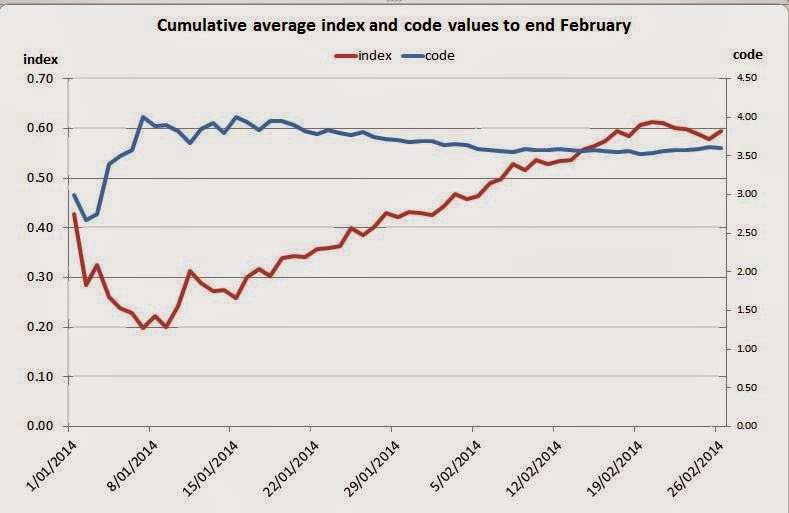Bird-a-day rolls through February 2014
The background to this project is summarised in the January report.
At the start of the year I had an objective of getting to the end of the year. With the help of a few rarities, that looked easy. Early in February things began to look a tad bleak: would I have to start using my "savers" to get through this month?
The answer is fortunately 'No."
Before getting to what has been seen, I will note that I have changed the way I calculate my index, which guides me in choosing the bird I select each day, For reasons which now escape me I had calculated the index as the product of scores for Carwoola and the COG Area of Interest (COGAOI). Where the bird hadn't been recorded in Carwoola I gave it a notional score of 0.0001. As time has progressed I realised that this gave very low indexes to birds that were unusual in Carwoola but very easy to get in Canberra. For example:
At the start of the year I had an objective of getting to the end of the year. With the help of a few rarities, that looked easy. Early in February things began to look a tad bleak: would I have to start using my "savers" to get through this month?
The answer is fortunately 'No."
Before getting to what has been seen, I will note that I have changed the way I calculate my index, which guides me in choosing the bird I select each day, For reasons which now escape me I had calculated the index as the product of scores for Carwoola and the COG Area of Interest (COGAOI). Where the bird hadn't been recorded in Carwoola I gave it a notional score of 0.0001. As time has progressed I realised that this gave very low indexes to birds that were unusual in Carwoola but very easy to get in Canberra. For example:
- Australasian Darter index 0.000018
- Australian Pelican index 0.007494
In both cases I'd rate these as a code 2 (Should get 80-100% of the time in area seen this time of year) for Bird-a day. In so doing I'd actually be placing weight on the need to go 30km to Canberra to see them: in Canberra I'd think about giving them code 1.
I have therefore changed the scoring to make it the sum of the two scores: if a bird is relatively unusual in Canberra but common in Carwoola it gets a highish index as it does if common in Canberra but unusual in Carwoola. (Of course birds that are bog-common in both get very high scores and those rare in both get very low scores.) Under the new scheme the two species above get scores that are considerably higher:
- Australasian Darter index 0.178179
- Australian Pelican index 0.331629
The picture represented by the two scores over the year to date is below.
The index value seems to have plateaued a little at the end as I have been 'getting' birds away from home (Spotted quail-thrush and Red-browed Treecreeper in Tallaganda; and Sooty Oystercatcher and Long-billed Corella in the Illawarra). Based on my experience of rarely observing the species I rate the Red-browed Treecreeper as the 'best' bird of the month, but I don't have an image of that. To give some 'pretty' to the post I repeat the image of the Long-billed Corella from Kiama.
In terms of everyday birds I rated three species as Code 2: Noisy Miner and White-throated Gerygone from home and Australian Reed-warbler from Lake Tuggeranong. The last species would have rated a code 3 in Carwoola but it's almost code 1 at a reedy waterbody in Canberra.
Beyond all the rigour implied above is a little fiddling. This is exemplified by Tawny Frogmouth which have a low index score they are generally found easily at home. So they are part of the safety regime and will be kept in my back pocket for a while.
Beyond all the rigour implied above is a little fiddling. This is exemplified by Tawny Frogmouth which have a low index score they are generally found easily at home. So they are part of the safety regime and will be kept in my back pocket for a while.





Comments